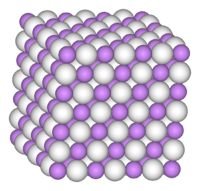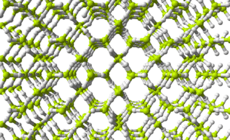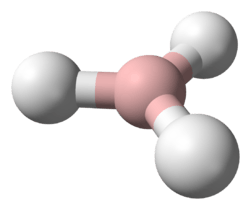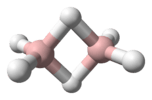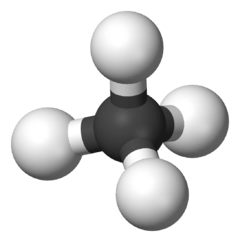Decaborane
 | |
| Names | |
|---|---|
| Other names
decaborane decaboron tetradecahydride | |
| Identifiers | |
| 17702-41-9 | |
| 3D model (Jmol) | Interactive image |
| ChemSpider | 21241886 |
| ECHA InfoCard | 100.037.904 |
| EC Number | 241-711-8 |
| |
| |
| Properties | |
| Molar mass | 122.22 g/mol |
| Appearance | White crystals |
| Odor | bitter, chocolate-like[1] |
| Density | 0.94 g/cm3[1] |
| Melting point | 97–98 °C (207–208 °F; 370–371 K) |
| Boiling point | 213 °C (415 °F; 486 K) |
| Solubility in other solvents | Slightly, in cold water. |
| Vapor pressure | 0.2 mmHg[1] |
| Hazards | |
| Main hazards | may ignite spontaneously on exposure to air[1] |
| Flash point | 80 °C; 176 °F; 353 K |
| 149 °C (300 °F; 422 K) | |
| Lethal dose or concentration (LD, LC): | |
| LC50 (median concentration) |
276 mg/m3 (rat, 4 hr) 72 mg/m3 (mouse, 4 hr) 144 mg/m3 (mouse, 4 hr)[2] |
| US health exposure limits (NIOSH): | |
| PEL (Permissible) |
TWA 0.3 mg/m3 (0.05 ppm) [skin][1] |
| REL (Recommended) |
TWA 0.3 mg/m3 (0.05 ppm) ST 0.9 mg/m3 (0.15 ppm) [skin][1] |
| IDLH (Immediate danger) |
15 mg/m3[1] |
| Except where otherwise noted, data are given for materials in their standard state (at 25 °C [77 °F], 100 kPa). | |
| | |
| Infobox references | |
Decaborane, also called decaborane(14), is the borane with the chemical formula B10H14. This white crystalline compound is one of the principal boron hydride clusters, both as a reference structure and as a precursor to other boron hydrides. It is toxic and volatile, with a chocolate-like odor.[3]
Handling properties and structure
B10H14 possesses a strong characteristic odor, sometimes described as musty or intensely bitter, chocolate-like that is unique to boranes. The physical characteristics of decaborane(14) resemble those of the organic compounds, such as naphthalene and anthracene, in that it can be sublimed under vacuum at moderate temperatures. Sublimation is the common method of purification. Like organic compounds, decaborane is highly flammable, but, like other boron hydrides, it burns with a bright green flame. It is not sensitive to moist air, although it hydrolyzes in boiling water, releasing hydrogen and giving a solution of boric acid. It is soluble in cold water as well as a variety of non-polar and moderately polar solvents.
In decaborane, the B10 framework resembles an incomplete octadecahedron. Each boron has one "radial" hydride, and four boron atoms near the open part of the cluster feature extra hydrides. In the language of cluster chemistry, the structure is classified as "nido".
Synthesis and reactions
It is commonly synthesized via the pyrolysis of smaller boron hydride clusters. For example, pyrolysis B2H6 or B5H9 gives decaborane, with loss of H2.[4] On a laboratory scale, sodium borohydride is treated with boron trifluoride to give NaB11H14, which is acidified to release borane and hydrogen gas.[3]
It reacts with Lewis bases (L) such as CH3CN and Me2S, to form derivatives with the formula B10H12·2L.
- B10H14 + 2 L → B10H12L2 + H2
These species, which are classified as "arachno" clusters, in turn react with acetylene to give the "closo" ortho-carborane:
- B10H12·2L + C2H2 → C2B10H12 + 2 L + H2
It is a weak Brønsted acid. Monodeprotonation generates the anion [B10H13]−, with again a nido structure.
Applications
Decaborane has no significant applications, although it has often been investigated. Since the molecule decomposes in a plasma, yielding monatomic boron ions, decaborane is potentially useful as a fuel for aneutronic fusion,[5] and for low energy ion implantation of boron in the manufacture of semiconductors. It has also been considered for plasma-assisted chemical vapor deposition for the manufacture of boron-containing thin films. In fusion research, the neutron-absorbing nature of boron has led to the use of these thin boron-rich films to "boronize" the walls of the tokamak vacuum vessel to reduce recycling of particles and impurities into the plasma and improve overall performance.[6]
Decaborane was also developed as an additive to special high-performance rocket fuels. Its derivates were investigated as well, e.g. ethyl decaborane. One patented fuel composition included vinyl decaborane-polyester copolymer. Vinyl decaborane ("dekene") is prepared by reacting decaborane with acetylene.[7]
Safety
Decaborane, like pentaborane, is a powerful toxin affecting the central nervous system, although decaborane is less toxic than pentaborane. It can be absorbed through skin. It forms an explosive mixture with carbon tetrachloride, which caused an often mentioned explosion in a Malta, New York, manufacturing facility in 1948 when CCl4 was used to clean the equipment.[8]
References
- 1 2 3 4 5 6 7 "NIOSH Pocket Guide to Chemical Hazards #0175". National Institute for Occupational Safety and Health (NIOSH).
- ↑ "Decaborane". Immediately Dangerous to Life and Health. National Institute for Occupational Safety and Health (NIOSH).
- 1 2 Gary B. Dunks, Kathy Palmer-Ordonez, Eddie Hedaya "Decaborane(14)" Inorg. Syn. 1983, vol. 22, pp. 202–207. doi:10.1002/9780470132531.ch46
- ↑ Greenwood, Norman N.; Earnshaw, Alan (1997). Chemistry of the Elements (2nd ed.). Butterworth-Heinemann. ISBN 0-08-037941-9.
- ↑ Lerner, E. J.; Terry, R. E. (2005). "Advances towards pB11 fusion with the dense plasma focus" (pdf).
- ↑ Nakano, T.; Higashijima, S.; Kubo, H.; Yagyu, J.; Arai, T.; Asakura, N.; Itami, K. "Boronization effects using deuterated-decaborane (B10D14) in JT-60U". 15th PSI Gifu, P1-05. Sokendai, Japan: National Institute for Fusion Science.
- ↑ US patent 3967989, Hawthorne, M. F., "High energy propellant compositions including vinyl decaborane-polyester copolymer binder", issued 1976
- ↑ "Condensed version of the 79th Faculty Research Lecture Presented by Professor M. Frederick Hawthorne". UCLA.
Further reading
- "Decaborane(14)". WebBook. NIST.
- "Boron and Compounds". National Pollutant Inventory. Australian Government.
- "Decaborane". Organic Chemistry Portal.
- "Boron compounds: decaborane (14)". WebElements.
- "NIOSH Pocket Guide to Chemical Hazards - Decaborane". Centers for Disease Control and Prevention.
